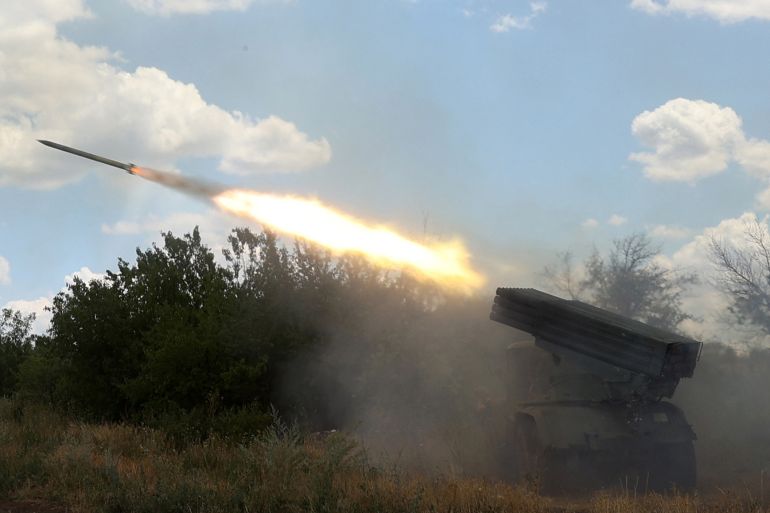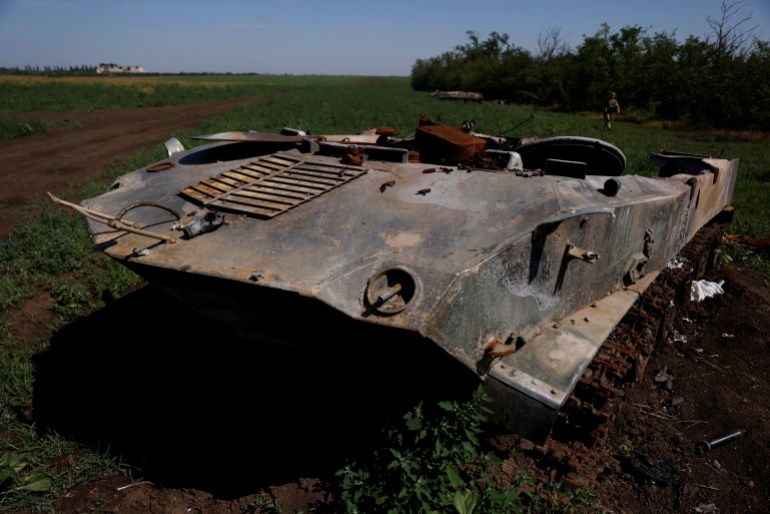Russia resumes eastern Ukraine offensive and expands war aims
Foreign minister says Russia has expanded its territorial aims in Ukraine beyond occupying the eastern Donbas region.

Russia appeared to expand its territorial ambitions in the 21st week of its war on Ukraine, as it resumed the offensive in the eastern Donetsk region and received some rare international support for what it calls a “special military operation”.
In an interview published by Russian state news agency Ria Novosti on Wednesday, Russian foreign minister Sergey Lavrov said Russia had departed from its shrunken official goal of occupying the two eastern regions of Luhansk and Donetsk, which together comprise the Donbas region.
Keep reading
list of 3 itemsUkraine’s first lady makes impassioned plea for more US arms
‘Putin’s war is against the whole world, not just Ukraine’
“It is not only about the DNR and LNR,” said Lavrov, referring to the regions by the acronyms of their self-proclaimed people’s republics, “but also the Kherson region, the Zaporizhia region, and also other territories,” he said.
After Russian forces withdrew from areas around Kyiv on March 25, Lavrov had said that the “special military operation” in Ukraine was over and Russia would focus on the two eastern regions.
But Russian forces have continued to occupy parts of the Kherson and Zaporizhia regions in southern Ukraine, which they seized early in the war, and escalate the “Russification” of the regions amid fears that Moscow is planning for annexation.
In May, Russian President Vladimir Putin signed a decree simplifying the process for residents in the Russian-held areas of those regions to apply for Russian passports and citizenship.
The Russian-installed government reportedly plans to introduce the Russian curriculum in local schools. Moscow’s most recent decree extends Russian censorship law to the Kherson and Zaporizhia regions, criminalising criticism of Russia. Offenders can be punished with deportation to Russia.
Lavrov’s remarks are more in line with the Kremlin’s pro-war critics, who say Putin has bided his time before expanding Russia’s war aims.
A day before Lavrov’s interview was published, Igor Girkin, a former military commander who was involved in fomenting the Donetsk and Luhansk uprisings in 2014, wrote in favour of “the reunification of Novorossiya with the Russian federation along the line Kharkiv-Dnipropetrovsk-Kryvyi Rih-Mykolaiv-Odesa (all inclusive)”.
Such a move would entail annexing all of eastern and southern Ukraine. Western Ukraine, Girkin suggested, could be annexed by Belarus.
Novorossiya, or New Russia, was the name given to southern Ukraine following its conquest and rule by Russia in 1764-1918, and includes the regions of Kherson and Zaporizhia.
Lavrov’s comments came after Russian defence minister Sergey Shoigu ordered a resumption of the offensive in the east and south, ending a brief operational pause following the capture of the Luhansk region.
Russian advances in recent weeks have been incremental, amid reports that its forces suffered high numbers of casualties. “We are slowly but surely, like a heavy steamroller, moving forward, at times inferior to the enemy in terms of the number of personnel,” wrote Russian military reporter Sergey Ischenko in Svobodnaya Pressa.
Shortage of combat power
A lack of new recruits to offset battlefield losses remains an issue for the Russian forces, according to a military think-tank.
“A 10-day-long operational pause is insufficient to fully regenerate Russian forces for large-scale offensive operations,” said the Institute for the Study of War (ISW). “The Russian military seems to feel continuous pressure to resume and continue offensive operations before it can reasonably have rebuilt sufficient combat power to achieve decisive effects at a reasonable cost to itself, however. The resuming Russian offensive may therefore fluctuate or even stall for some time.”
Russia has made moves to address its losses, which Ukraine now estimates at just less than 39,000 men in six months of war. CIA director William Burns estimates Russia’s dead at 15,000, and its wounded at 45,000. Russia’s initial invasion force was estimated at 120,000 troops.
Russian military reporters have said an effort is under way to generate “dozens” of new battalions through voluntary recruitment. According to Biznes Online, the region of Tatarstan will provide two battalions of 400 men each.
In early June, the Kremlin reportedly ordered the country’s 85 regions, including the regions of Crimea and Sevastopol in occupied Ukraine, to generate at least a battalion each, and has mobilised large financial resources to achieve this. Recruits will be paid a $3,500 (200,000 roubles) sign-up fee, and $3,800-$6,100 (220,000-350,000 roubles) a month. Family members are to receive health and life insurance, and university places.
The ISW said many of these battalions are already in training, and estimated that Russia could generate a force of 34,000 men by the end of August if each region provides at least one battalion of 400 men each.
Ukraine’s military intelligence said Russia has opened 500 cadet classes and 1,000 junior army classes in Belgorod. These take in trainees aged eight to 18, and are deemed to be an attempt at long-term force regeneration, following losses sustained in Ukraine. Some Russian military observers have urged compulsory conscription.
Russia losing ammunition
Russia’s problems have not been confined to personnel. Ukraine has been attacking Russian ammunition stores far behind the line of contact with increasing frequency since it started receiving HIMARS multiple launch rocket systems from the United States.
On July 13, Ukraine’s southern command said it struck Russian ammunition depots in Chornobaivka near occupied Kherson, and Novopetrivka in the occupied Zaporizhia region. The next day, Ukraine’s Kherson administration said forces destroyed an ammunition warehouse in Radenska.
Ukraine’s military intelligence reported that Russian occupying forces delivered truckloads of artillery ammunition for storage in Kherson’s municipal theatre on the night of July 11-12 – possibly an attempt to discourage Ukrainian attacks by shielding ammunition inside monuments. Melitopol mayor Ivan Fedorov said Russian forces are storing military equipment and ammunition near residential areas to use civilians as human shields.
Ukraine’s southern command said its air force destroyed Russian matériel, including an ammunition warehouse on July 16, killing 18 soldiers, in Lazurne, in the Kherson region. Former parliamentarian Sergey Khlan confirmed the blaze at the Seagull sanatorium, which he said the Russians were using as an ammunition depot.
The ISW said the destruction of ammunition depots has likely degraded Russian forces’ ability to sustain high volumes of artillery fire along front lines. “Detected heat anomalies from NASA’s Fire Information for Resource Management System (FIRMS) remotely sensed data decreased significantly in Donbas starting around July 10,” said the ISW, noting that it also coincided with Russia’s operational pause of July 6-15.

On July 17, the destruction continued. A Kherson official said a cache of Russian munitions was exploding in Nova Kakhova in the Kherson region. Ukraine posted video of the explosion. Ukraine’s southern command said its forces also struck two Russian ammunition warehouses in the Mykolaiv region.
Two days later, Ukraine’s southern command said it destroyed a Russian ammunition depot in Snigurivka in the Mykolaiv region, killing 65 Russian soldiers. It also said it destroyed ammunition depots in Raiske and Berislav.
Ukraine’s military intelligence reported that Russia has tasked its military attachés in the EU with recruiting local officials involved in the transportation of military assistance to Ukraine – which could be part of an attempt to target Western military aid before it arrives.
On July 15, Ukrainian defence minister Oleksiy Reznikov announced that the first M270 units had arrived in Ukraine. The M270 is a HIMARS-type multiple launch rocket system that carries twice as many rockets.
Meanwhile, the civilian death toll continued to soar. The deadliest attack on civilians came on July 14, when a salvo of Russian missiles killed at least 23 people in Vinnytsia, 200km southwest of Kyiv. Moscow has denied targeting civilians.

There was a rare bit of good diplomatic news for Russia, which has been isolated by Western opprobrium and sanctions.
Iranian Supreme Leader Ayatollah Ali Khamenei backed Putin over the invasion of Ukraine as a response to NATO, during a meeting in Tehran on July 19.
“War is a violent and difficult issue and the Islamic Republic is in no way happy that civilians get caught up in it, but concerning Ukraine, had you not taken the initiative, the other side would have taken the initiative and caused the war,” Khamenei was quoted as saying.
“NATO would know no bounds if the way was open to it, and if it was not stopped in Ukraine, it would start the same war using Crimea as an excuse.”